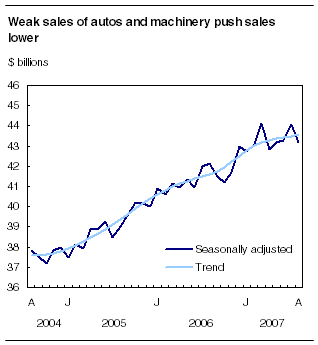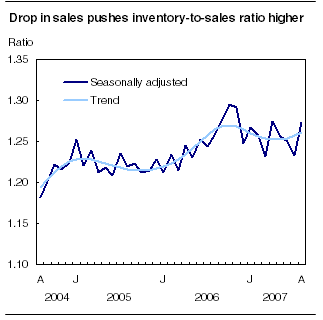Common menu bar links
Wholesale trade
Archived Content
Information identified as archived is provided for reference, research or recordkeeping purposes. It is not subject to the Government of Canada Web Standards and has not been altered or updated since it was archived. Please "contact us" to request a format other than those available.

Weaker sales of automotive products and machinery and electronic equipment pushed wholesale sales substantially lower in August, bringing to an end a string of three straight monthly increases.
Wholesale sales fell 2.0% to an estimated $43.2 billion in August. The decline completely offset the gains of 1.8% in July and 0.3% in June.
Around half of the decline in August was due to weaker sales of automotive products (-5.3%), more than offsetting last month's gain (+3.5%). The machinery and electronic equipment sector also had a slow month as sales fell 4.2%, but this followed three months of strong gains. The other notable decline came in the building materials sector (-2.2%), where lower lumber sales were a major contributing factor.
Wholesalers of food, beverage and tobacco products posted the only notable increase (+1.0%) in August, while sales of personal and household goods edged up slightly (+0.3%).
Sales in constant prices, which take price fluctuations into account, fell by 1.0% in August.

Automotive sales reverse course
The increasingly volatile automotive sector reversed course in August, as sales fell 5.3% to $7.7 billion. This more than offset the 3.5% rise in July, and brought this sector's monthly sales to their lowest level since November 2006.
A sizeable drop in motor vehicle sales (-6.6%) was behind this month's decline. Meanwhile, sales of motor vehicle parts and accessories edged up slightly (+0.2%).
The drop in motor vehicle sales followed a 4.4% gain in July and was the fourth decline in five months for this trade group. Despite these recent downturns, motor vehicle sales in the first eight months of the year were still slightly ahead (+1.1%) of the same period last year.
Demand for machinery and electronic equipment falls after hitting record high in July
After hitting a record high in July, sales in the machinery and electronic equipment sector fell 4.2% to $9.2 billion in August. This was only the second decline so far this year for this sector.
Around three-quarters of the drop was due to weaker demand in the machinery and equipment trade group, where sales tumbled 6.5% to $4.4 billion. Although this was the largest monthly drop in four years for this trade group, it also followed three months of healthy gains.
The two other trade groups that make up this sector also reported weaker sales in August. The computer and other electronic equipment trade group fell for the third time in four months, dropping 2.4% to $2.7 billion, while the office and professional equipment trade group registered a more modest drop (-1.4%) to $2.1 billion.
Large decline in lumber sales drives building material sector lower
The building materials sector registered its first decline in four months in August, mostly because of weaker lumber sales. Overall sales in this sector declined 2.2% to $6.2 billion after rising 1.4% in July.
The largest drop came in the lumber and millwork trade group, where sales fell 8.7% to $1.0 billion on the back of a 3.2% decline in July. Around a third of the sales from this trade group consists of exports to the US, and lumber wholesalers continue to be buffeted by the slowdown in the US housing market (housing starts in the US hit their lowest level in more than a decade in August) along with weak lumber prices and a strong Canadian dollar.
After declining 11.6% in 2006, exports of lumber products fell a further 15.7% in the first eight months of the year, according to the latest international trade data.
Sales of metal products fell for the first time in four months in August, down 2.5% to $1.4 billion. Meanwhile, sales of building supplies remained essentially unchanged (-0.1%) in August following a 1.8% increase in July.
Ontario and British Columbia bear the brunt of August sales decline
Ontario and British Columbia bore the brunt of the decline this month.
Ontario was particularly hard hit by the drop in automotive sector, as overall sales in the province hit their lowest level of the year, falling 2.9% to $21.2 billion.
Wholesale sales in British Columbia fell for only the second time this year, down 4.9% to $4.5 billion. Declines were widespread, with the most significant drops coming in the personal and household goods, building materials, machinery and electronic equipment and "other products" sectors.
Sales in Saskatchewan headed down for the fifth consecutive month, falling a further 4.3% to $1.2 billion. As in previous months, the largest drop was in the "other products" sector, which had seen a substantial run-up in sales during the first quarter of the year. Nevertheless, the province's overall sales in the first eight months of the year are still up substantially over the same period in 2006, bolstered by a very strong first quarter.
The Atlantic provinces presented a mixed picture in August, with drops in Newfoundland and Labrador and Prince Edward Island offset by gains in Nova Scotia and New Brunswick.
After registering a huge increase in July, sales in Nunavut returned to more normal levels in August. Nevertheless, sales in the first eight months of the year were still up substantially from the same period in 2006, thanks to a dramatic jump in investment in the mining sector.
Inventory-to-sales ratio matches its highest level of the year
Wholesale inventories rose for the sixth time in eight months in August, up 1.2% to $54.9 billion.
The increase in inventories was widespread, with 13 of the 15 trade groups reporting higher inventory levels in August. Among the most notable movers in dollar terms were pharmaceuticals (+3.4%), motor vehicles (+2.2%), computer and other electronic equipment (+4.4%) and other products (+1.4).

Only the lumber and millwork (-2.0%) and metal products (-1.1%) trade groups reported lower inventory levels in August.
With sales falling substantially this month and inventories on the rise, the inventory-to-sales ratio matched its highest level of the year, jumping from 1.23 in July to 1.27 in August.
The inventory-to-sales ratio is a key measure of the time, in months, that would be required to exhaust existing inventories if sales were to remain at their current level.
Available on CANSIM: tables 081-0007 to 081-0010.
Definitions, data sources and methods: survey number 2401.
The August 2007 issue of Wholesale Trade (63-008-XWE, free) will soon be available.
Wholesale trade estimates for September will be released on November 19.
To obtain data or general information, contact Client Services (toll-free 1-877-421-3067; 613-951-3549; wholesaleinfo@statcan.gc.ca). For more information or to enquire about the concepts, methods or data quality of this release, contact Marc Atkins (613-951-0291; marc.atkins@statcan.gc.ca), Distributive Trades Division.


 Table(s).
Table(s).